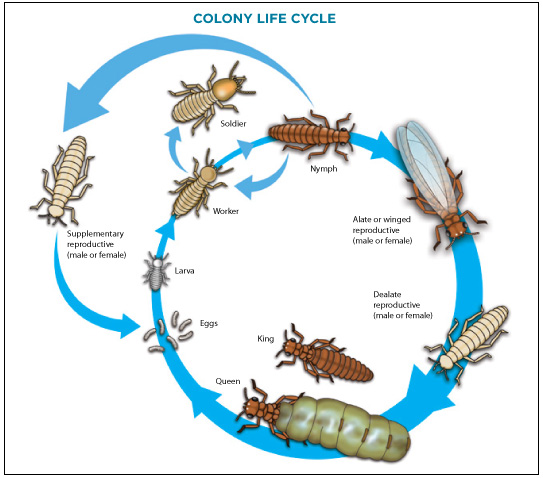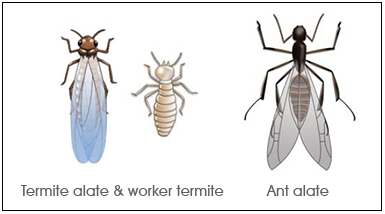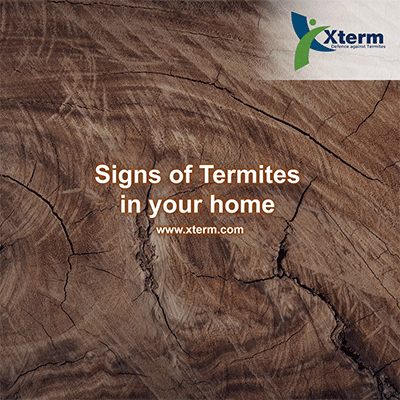Termites
What are Termites?
Termites are soft-bodied insects commonly known as white ants. They are small in size (4-11 mm) and have three distinct body parts namely, the head, thorax and abdomen. Termite colonies have a number of different looking individuals known as castes. Each caste has its own duties within a colony. The largest member in a termite colony is the termite queen. Incidentally, it is also the longest living insect in the world.

Termites are insects classified under the order Blattodea. They are sometimes regarded as social cockroaches due to their close phylogenetic relationship to cockroaches. The wings, when present, are long, slender, in two pairs and of similar size and shape. These are usually shed following a short nuptial flight after which males and females pair up to start a new colony.
Termites are social insects, characterised by the allotment of labour within the castes with the sharing of food, shelter and resources and cooperation in rearing the young. The castes include the worker, soldier and reproductive. Social groups of subterranean termites are composed of both males and females, unlike most other social insects where the majority of members are females.
What Is A Termite Colony?

Worker Caste
Worker termites are physically and sexually immature males and females. They are the most abundant caste in a termite colony. They undertake the task of foraging for food, food storage, brood caring, nest maintenance, excavating, repairing and building galleries and shelter tubes.
Workers are the only caste with the ability to digest the cellulose in wood. This is achieved with the help of flagellates in the gut that assist in cellulose digestion.
These wingless insects are typically the first termites seen when an active shelter tube or a piece of infested log is disturbed.
Soldier Caste
Soldier termites are physically and sexually immature males and females whose primary function is colony defense. Many have enlarged jaws that render them incapable of feeding themselves. Therefore, they depend on the workers to provide them with regurgitated food. The head of a soldier is enormously elongated.
They have enormously elongated. They have both atomical and behavioural specialisations.
Termite soldiers are usually blind but in certain families, soldiers that developed from the reproductive line have partly functional eyes. Species identification and other taxonomic work is often conducted using the soldiers’ heads, mandibles and nasus due to each species’ distinct characteristics.
Reproduction Caste
The alates or winged reproductives have two pairs of wings that are equal in size. Alates possess fully functional eyes and can withstand dehydration. This particular caste is often mistaken for a flying ant, an error that results in many not realising that termites exist in the vicinity of their property.
The reproductives play an important part in establishing new colonies. There are three types of reproductive in a termite colony known as “Primary”, “Secondary” and the “Tertiary” reproductives.
Primary reproductives are swarmers (alates) who have successfully survived the dangers of the dispersal or “nuptial” flight and settled down to lay and nurse the first brood.
When a termite colony becomes too large, and the queen cannot lay sufficient eggs to sustain it, Secondary sexually competent reproductives are produced to ease the queen’s burden. Although these secondary reproductives lay fewer eggs than the queen, there can be hundreds of them in an established colony.
Their contribution to the egg-laying capacity of a colony can be tremendous and when a queen dies, they can take over the total reproduction requirement. Tertiary reproductives are derived from fully developed workers when a certain part of the colony is isolated from its main colony. These reproductives or ergatoids, are wingless and look like big workers.
Difference Between Termites & Ants

There are three main morphological differences that distinguish winged termites from winged ants. Termites have beaded antennae that are straight to slightly curved, while ants have a pair of distinct elbowed antennae.
Winged termites have a broad waist, unlike that of ants’ which is constricted. Termite wings are of the same size, whilst the front pair on ants are much longer.
How Termites Enter Homes/Properties
Termites are in constant movement in the soil in search of food. A property may be safe today but not tomorrow. They can crawl through cracks as thin as a piece of paper to enter our homes. These tiny creatures respond to environmental cues such as moisture and temperature gradients. Foundation cracks, wall joints, gaps around plumbing and pipes are all possible entry points.
Although termites are thought to wander about underground at random, there have been studies that indicate otherwise. Termites search areas within tunnels spreading out from the colony in a radial pattern. These search patterns divide and subdivide so that they are able to cover as wide an area as possible. In other words, sooner or later, if a property exists in the area they will find it.
What Are The Warning Signs?

Termites rarely come to the surface to feed. Most of the time, you will only find out that they are there when it is too late and damage has occurred.
However, there are signs that one could look out for, the below are some indications.
Signs of Termites
- Swarmers in or around the house, especially near light sources after rain.
- The presence of mud shelters on foundations or other walls running from the ground upwards in to the house.
- Stray wings left near doors and windows.
- Paint that has started to bubble on wood surfaces that sound hollow when knocked.
- Acoustic signals of termites gnawing on and knocking against wood surfaces.
Find out why the Xterm® baiting is the most effective method to get rid of termites.
